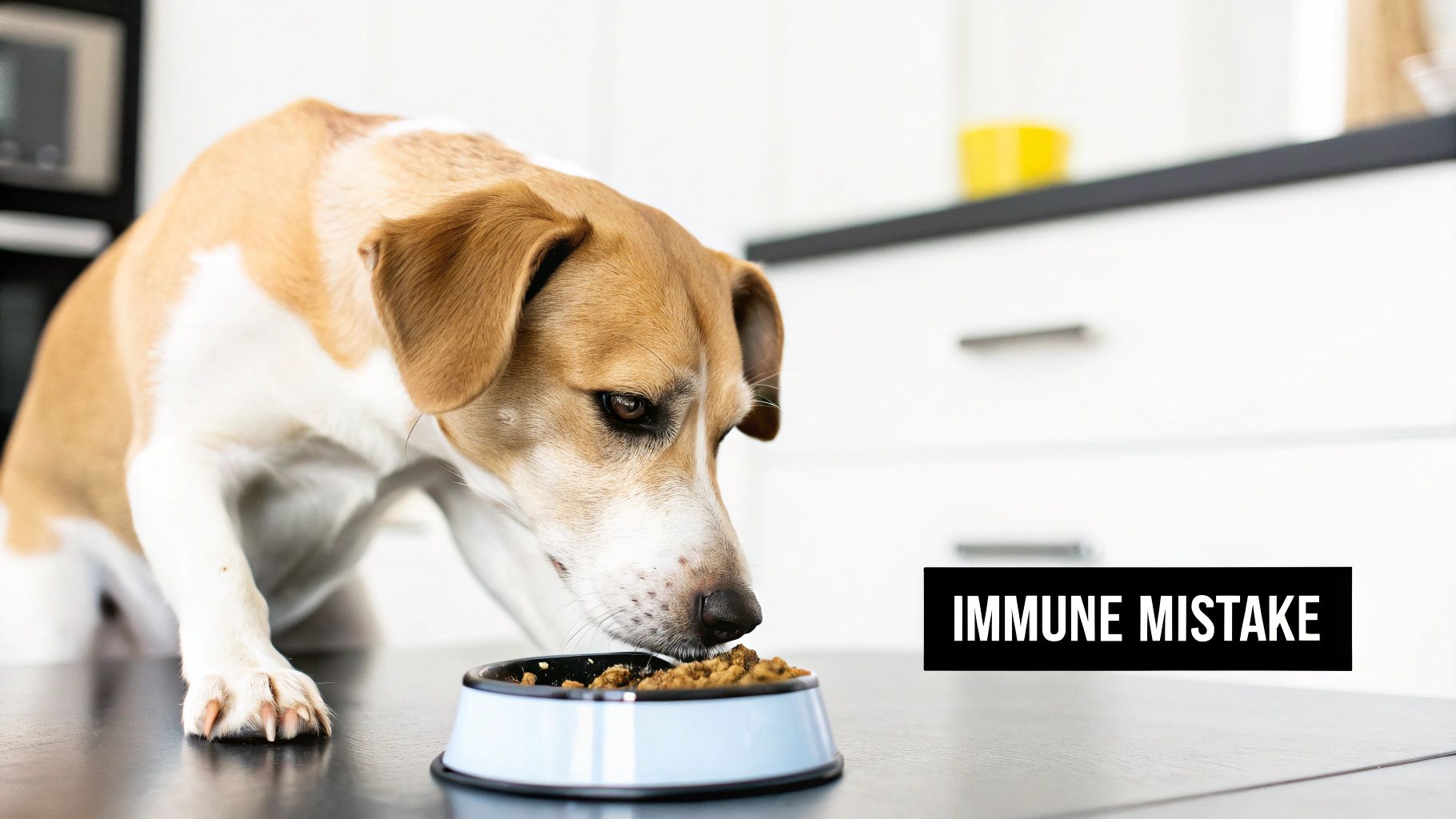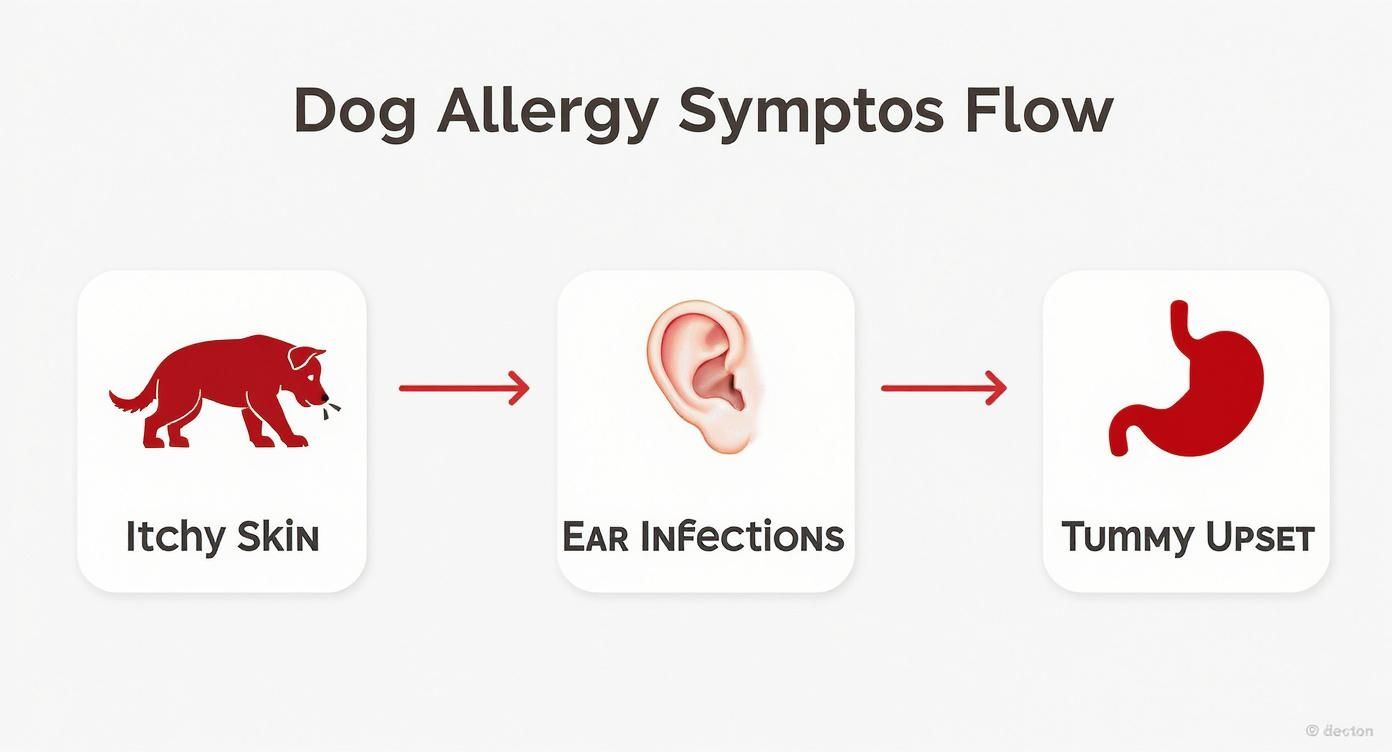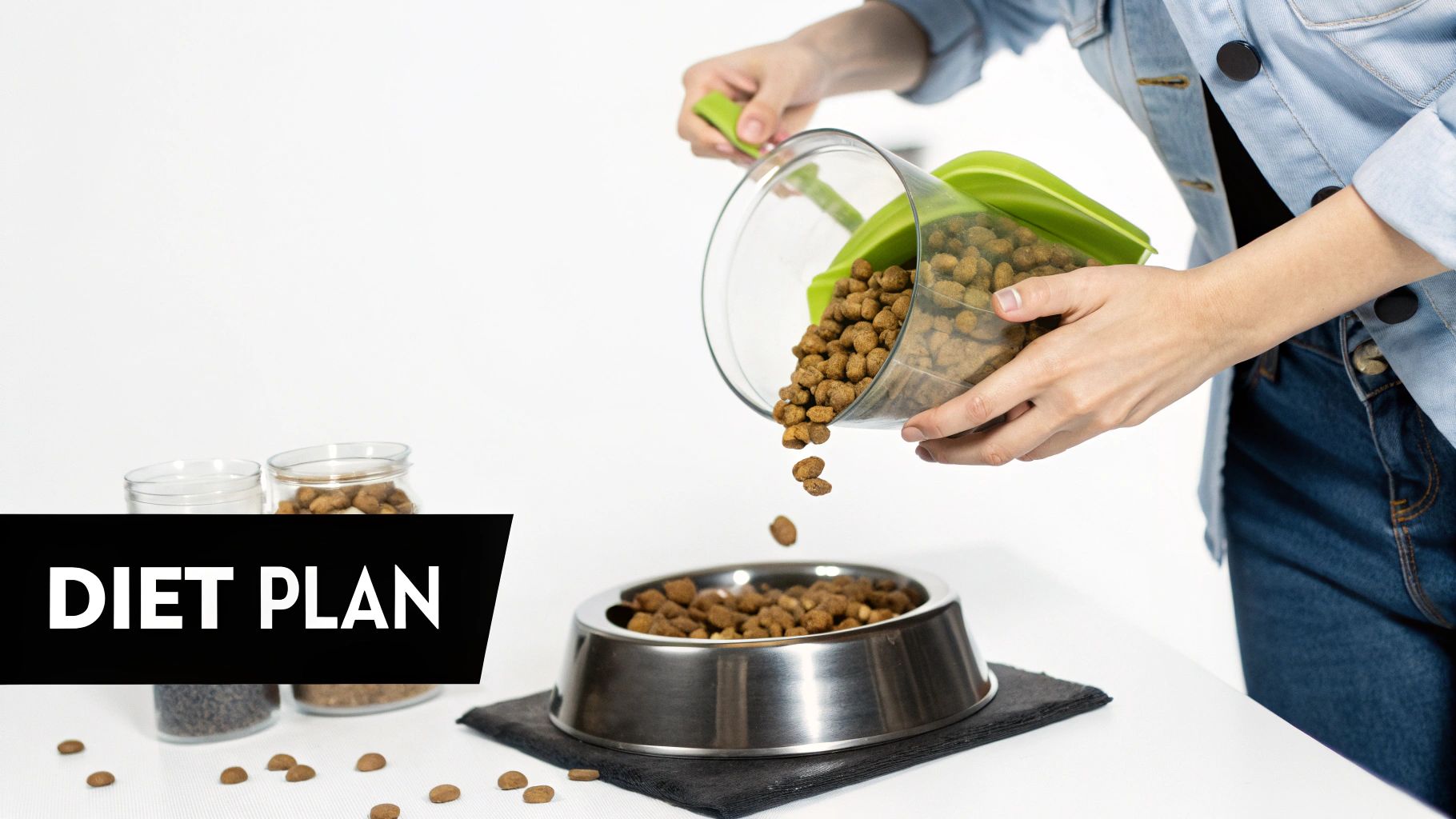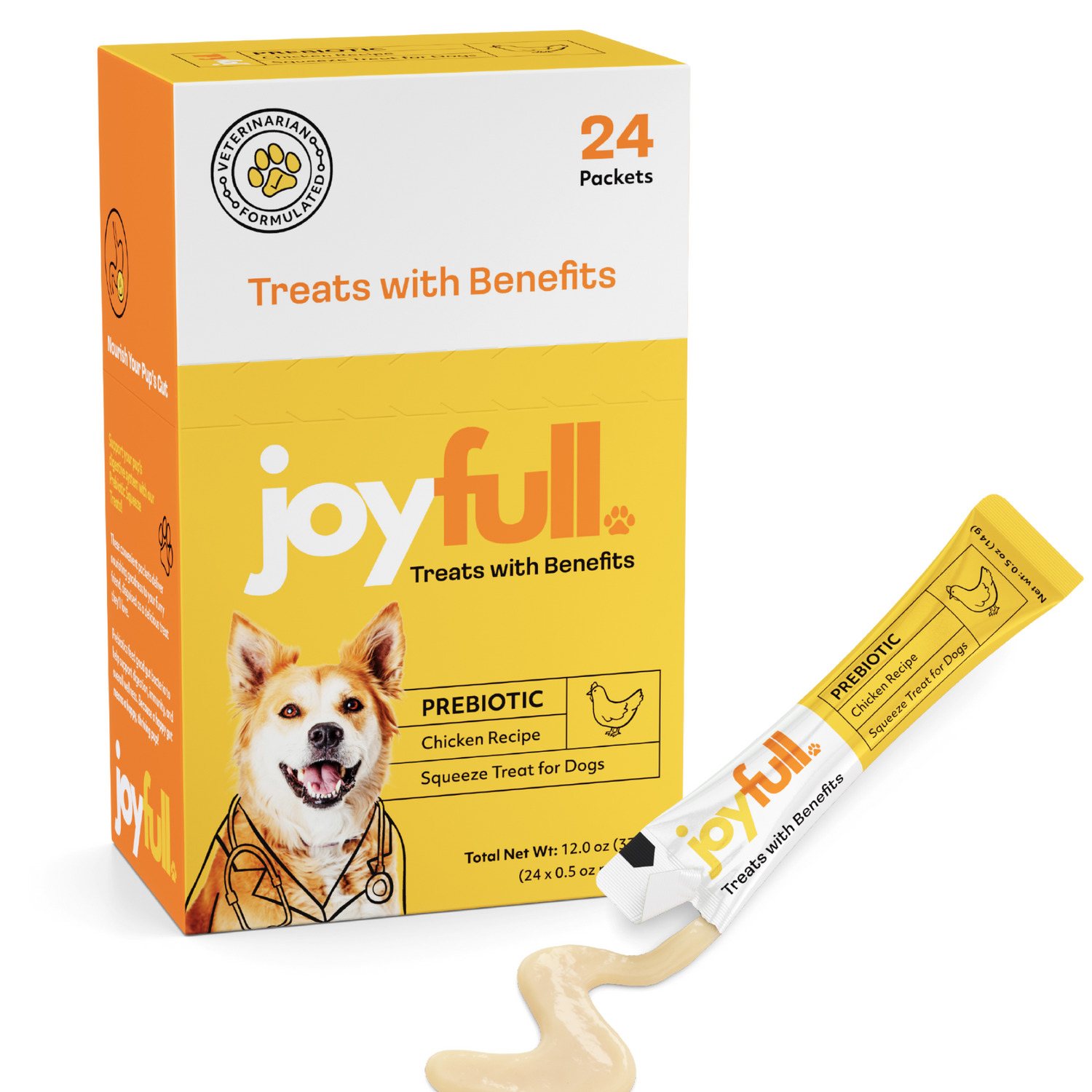
What Causes Food Allergies in Dogs Explained
So, what’s really going on when a dog has a food allergy? It's all about a case of mistaken identity.
Think of your dog's immune system as a highly trained security guard. Its job is to spot and neutralize genuine threats like bacteria and viruses. But with a food allergy, this security system makes a critical error. It flags a harmless food protein—something as common as chicken or beef—as a dangerous invader and launches a full-blown attack.
Decoding Your Dog's Food Allergy
This isn't an instant reaction. A true food allergy is a complex immune response that builds up over time. It’s quite different from a food intolerance, which is more of a digestive hiccup—like getting an upset stomach after eating something that doesn't agree with them.

The immune system has to be "trained" to see the food as a threat, a process called sensitization. This is why a dog can eat the same food for years without any problems and then suddenly develop an allergy to it. Once sensitized, every meal containing that ingredient triggers an inflammatory cascade, leading to those frustrating symptoms we see on the outside—the endless scratching, chronic ear infections, or stomach troubles.
The Most Common Food Culprits
You might be surprised to learn that the most common triggers aren't rare or exotic ingredients. They're actually some of the most widely used proteins in commercial dog foods. The more a dog is exposed to a particular protein, the more likely their immune system is to eventually flag it as an enemy.
It all comes down to a handful of specific proteins. Research shows the most common culprits are beef (triggering 34% of cases), dairy products (17%), chicken (15%), and wheat (13%). Knowing what to look for is half the battle.
Common Food Allergens in Dogs at a Glance
Getting familiar with the top offenders is a huge step toward helping your dog. The table below breaks down the most frequent allergens and where you’ll typically find them hiding in your dog's food and treats.
| Food Allergen | Percentage of Allergic Dogs Affected | Common Sources in Dog Food |
|---|---|---|
| Beef | 34% | Kibble, wet food, treats, dental chews, beef-based broths |
| Dairy | 17% | Cheese, yogurt, milk-based treats, some prescription diets |
| Chicken | 15% | Kibble, wet food, treats, chicken meal, chicken fat |
| Wheat | 13% | Kibble binders, pasta, bread-based treats, some biscuits |
Learning how to spot these on an ingredients list is a crucial skill for any pet parent navigating allergies. Our guide on how to read dog food labels is a great place to start building that expertise.
Key Takeaway: Remember, a food allergy doesn't mean a food is "bad." It simply means your individual dog's immune system has decided to overreact to a specific protein. The goal isn't to find a "no-allergen" food, but to pinpoint and remove the one ingredient that's causing your dog's discomfort.
How Your Dog's Immune System Triggers an Allergy
To get to the bottom of what causes food allergies in dogs, you have to picture a tiny, invisible battle happening inside their body. Think of your dog’s immune system as a sophisticated, well-meaning army. Its main job is to identify and take out real threats, like viruses and bacteria. But with a food allergy, this army makes a crucial mistake.
It misidentifies a perfectly harmless protein from your dog's food—like beef or chicken—as a dangerous invader. This case of mistaken identity is what kicks off the entire allergic reaction, turning a simple meal into the trigger for widespread inflammation.

This doesn't just happen overnight. The immune system has to be "primed" to see the food as a threat first. This initial phase, known as sensitization, can take months or even years while your dog eats the same food with no problems at all.
The Allergic Cascade, Step by Step
Once the immune system has flagged a food protein as an enemy, it prepares its defenses. The whole thing is a biological chain reaction involving a few key players that work together to create the symptoms we end up seeing.
The process unfolds in a predictable, multi-step sequence:
-
The First Encounter: The first time the immune system decides a food protein is a threat, it creates special soldiers called Immunoglobulin E (IgE) antibodies. These are highly specific, designed to recognize only that particular protein.
-
Setting the Trap: These IgE antibodies then travel through the body and latch onto mast cells. Think of mast cells as biological landmines, packed with potent inflammatory chemicals like histamine. They are strategically placed in areas that see a lot of action from the outside world, like the skin, gut, and respiratory tract.
-
Pulling the Trigger: The next time your dog eats that food, the protein is absorbed and travels through the body. It eventually finds and binds to the IgE antibodies waiting on the mast cells. This connection is the trigger, causing the mast cells to "degranulate"—or, more simply, explode.
This explosion unleashes a flood of histamine and other chemicals into the surrounding tissues. It's this chemical release that causes all the classic signs of an allergy: the maddening itch, red skin, swelling, and stomach upset. It's the body's over-the-top reaction to what was really a false alarm.
The Immune System's Miscalculation: The science behind this is called a type I hypersensitivity reaction. The immune system mistakenly tags food proteins as harmful. When the dog is exposed again, cells release IgE antibodies specific to that allergen. These antibodies bind to mast cells, which then release the inflammatory chemicals that cause the allergic symptoms you see. You can get a more technical look into the science behind food allergies here.
Why the Skin and Gut Are Ground Zero
Ever wonder why food allergies almost always show up as skin problems or an upset stomach? It’s because the skin and the gastrointestinal tract have a massive population of mast cells. They are the body's primary barriers, so they are heavily armed with these immune sentinels.
When the allergic reaction kicks off, the chemical release is concentrated right in those areas. This is why a food allergy can lead to:
- Intense Itching: Histamine directly pokes the nerve endings in the skin, creating that relentless urge to scratch.
- Skin Inflammation: Other chemicals make blood vessels leaky, which leads to redness, hives, and hot spots.
- Digestive Upset: The same process happening in the gut lining can cause vomiting, diarrhea, and general discomfort.
Understanding this mechanism is really the key. It makes sense of why symptoms can pop up hours or even days after a meal and why treatments are often geared toward either blocking histamine or calming down the overactive immune response. By grasping the "how," you're much better prepared to tackle the "what's next" in managing your dog's health.
Recognizing the Symptoms of a Food Allergy
Trying to figure out if your dog has a food allergy can feel like putting together a puzzle without all the pieces. The clues aren't always obvious and can easily be mistaken for other, more common health problems. It’s not a one-off issue like a scraped paw; instead, you're looking for a persistent, chronic pattern of discomfort that affects your dog from nose to tail.
This isn't just about an occasional scratch or a single bout of an upset stomach. It’s a relentless cycle of irritation driven by an overactive immune system. Learning to spot this pattern is the first, most important step toward getting your dog the relief they desperately need.
Telltale Skin and Coat Symptoms
If a food allergy is the problem, your dog's skin is usually the first place you'll see the evidence. In fact, over 70% of canine food allergies show up as skin-related issues. Think of the skin as ground zero for the allergic reaction, where the constant internal release of histamine creates a state of perpetual irritation that's hard to miss once you know what to look for.
Keep an eye out for these specific signs:
- Chronic Itching: This is the big one. We're not talking about a quick scratch behind the ears. It's that obsessive, can't-seem-to-stop scratching, licking, or chewing, often focused on the paws, belly, groin, and face.
- Recurrent Ear Infections: Do you feel like you're constantly back at the vet for another ear infection? A food allergy could be the root cause. The skin inside the ear canal gets inflamed, creating the perfect warm, moist playground for yeast and bacteria to take over, leading to those smelly, painful infections.
- Paw Licking and Chewing: Dogs with food allergies are notorious for obsessively licking and chewing their paws. They'll go at it until their feet are red, raw, and sometimes even stained brown from their saliva. This is a classic sign of allergic itching.
- Skin Rashes and Hot Spots: You might notice red, bumpy rashes popping up, especially on your dog’s belly, in their armpits, or around the groin. These inflamed areas can quickly turn into "hot spots"—those angry, weeping sores that develop when a dog won't stop licking and chewing at an itchy spot.
Gastrointestinal Clues to Watch For
While skin problems are the most common complaint, a dog's gut is the other main battleground for a food allergy. It makes perfect sense when you think about it—the problem starts with something they ate, so their digestive system is bound to react.
Gastrointestinal (GI) symptoms can show up alongside the skin issues, or sometimes they appear on their own. The inflammation triggered by the allergen messes with the normal function of the stomach and intestines, leading to some pretty clear signs of discomfort.
Look for these digestive red flags:
- Increased gassiness (and we mean really gassy)
- Loose stools or chronic diarrhea
- Occasional vomiting
- Having to go to the bathroom more often than usual
Because these symptoms overlap with so many other conditions, it's easy for pet parents to miss the connection to their dog's diet at first.
Food Allergy vs Food Intolerance What's the Difference
People often use "allergy" and "intolerance" interchangeably, but in veterinary medicine, they describe two completely different problems. Getting this distinction right is crucial to understanding what causes food allergies in dogs versus what just causes a simple stomachache.
An allergy is an immune system problem, plain and simple. An intolerance, on the other hand, is just a digestive issue. This table breaks it down.
| Feature | Food Allergy | Food Intolerance |
|---|---|---|
| Underlying Cause | An immune system overreaction to a specific food protein. | The digestive system cannot properly break down an ingredient. |
| Bodily Response | Involves IgE antibodies and histamine release. | A metabolic or digestive issue, no immune involvement. |
| Primary Symptoms | Intense itching, skin inflammation, ear infections, hot spots, GI upset. | Primarily digestive signs like gas, diarrhea, or vomiting. |
| Onset of Symptoms | Can be delayed, appearing hours or even days after eating the food. | Usually occurs within a few hours of consumption. |
A simple way to think about it is that a food allergy is a systemic, body-wide "freak-out" by the immune system. A food intolerance is a localized problem in the gut, like a person who gets an upset stomach from dairy because they lack the enzyme to digest it.
Because so many of these signs—from itching to diarrhea—can mimic other health problems like environmental allergies, parasites, or infections, trying to diagnose this at home is a bad idea. The only way to know for sure is to team up with your veterinarian. They can help rule out other potential causes and walk you through the proper diagnostic steps to figure out if a food allergy is truly what’s making your dog miserable.
How Vets Diagnose Food Allergies in Dogs
If you’re pretty sure your dog’s food is making them miserable, the next step is getting a real diagnosis. Just guessing which ingredient is the culprit can lead to months of frustration with no relief for your poor pup. This is where your veterinarian becomes your most important ally, guiding you through the only truly reliable process for figuring this out.
You might have heard about blood, saliva, or even hair tests for food allergies. While these can be tempting shortcuts, vets widely agree they are unreliable for food allergies. The results often produce false positives, pointing a finger at foods your dog isn't actually allergic to and sending you down a completely wrong path.
The Gold Standard: An Elimination Diet
To get answers you can trust, there’s really only one way to do it: an elimination diet, also called a food trial. It's the gold standard for a reason—it’s the only method that can definitively prove a link between what your dog eats and how they feel.
The idea is simple. You remove all potential food triggers to let the body calm down. Then, you reintroduce old foods one by one to see which one causes the symptoms to flare back up. It takes some serious patience and commitment, but it’s the most accurate diagnostic tool we have.
Your vet will guide you through a strict elimination diet for food allergies. The process is broken down into a few critical stages, and success depends on following each one perfectly.
Step 1: Choosing the Right Trial Diet
First things first, your vet will help you pick a special diet. The whole point is to find ingredients your dog has never eaten before, so their immune system doesn't recognize them and has a chance to reset. There are two main approaches here:
-
Novel Protein Diets: These foods are built around a single protein source that’s new to your dog. Think venison, kangaroo, duck, or rabbit, usually paired with a single carbohydrate like sweet potatoes or peas.
-
Hydrolyzed Protein Diets: These are prescription diets where the protein (often something common like chicken) has been scientifically broken down into tiny pieces. The molecules are so small that the immune system doesn't even recognize them as an allergen, basically making the protein "invisible" to the body's overactive defenses.
Your vet will weigh the options based on your dog's complete dietary history and recommend the best starting point.
Step 2: The Strict 8 to 12 Week Trial
With the new food in hand, the trial begins. For the next 8 to 12 weeks, your dog can eat absolutely nothing else. This is, without a doubt, the hardest part for pet owners, but it's non-negotiable for getting an accurate result.
Absolute Strictness is Everything: A single dropped piece of cheese, a lick of another pet's food, a flavored toy, or a treat from a well-meaning friend can set the immune system off again. One tiny slip-up can invalidate the entire trial, and you'll have to start from square one.
That means a temporary ban on everything else:
- All treats and chews
- Table scraps (no matter how much they beg)
- Flavored medications or supplements
- Flavored toothpaste
Patience is your best friend here. While tummy troubles might clear up in a couple of weeks, it often takes the full 8 to 12 weeks for all that skin inflammation and chronic itching to finally resolve.
This flowchart shows how symptoms can snowball, often leading owners to suspect a food allergy is the root cause.

You can see how something that starts as itchy skin can spiral into recurring ear infections and digestive upset, creating a frustrating, chronic cycle.
Step 3: The Rechallenge Phase
If your dog's symptoms are gone—or at least dramatically better—by the end of the trial, it’s time for the final, proof-positive step: the rechallenge. This is how you confirm the diagnosis.
Working with your vet, you'll start reintroducing ingredients from your dog's old diet, but only one at a time. For instance, you might add a small amount of plain, cooked chicken back into their diet for a week or two while keeping everything else the same.
If the itching, ear scratching, or stomach upset comes roaring back, you’ve found your culprit. You now know for certain your dog is allergic to chicken. If nothing happens, you’ll move on to the next potential trigger from their old food, like beef, and repeat the process. It's a methodical approach, but it removes all the guesswork and gives you a clear, confident path forward for managing your dog's health.
Long-Term Management for Your Allergic Dog
Getting that final diagnosis is a huge weight off your shoulders, but it’s also the first step on a new path. The real work begins now: creating a sustainable lifestyle that keeps your dog happy, comfortable, and free from those frustrating symptoms. Long-term management of a food allergy all comes down to one golden rule: strict, lifelong avoidance of the trigger ingredient.
That might sound intimidating, but it’s more manageable than you think once you have a solid plan. Try to see it less as a restriction and more as a personalized wellness plan designed just for your dog. Your goal is simply to provide a clean, safe diet that nourishes their body without sounding the immune system's alarm bells.

Success is all about consistency. Once you know what’s causing the problem, you become your dog's chief protector, making sure every meal, treat, and sneaky table scrap is safe.
Choosing the Right Diet for Life
With the elimination diet done and the culprit identified, your vet will help you pick a food for the long haul. You’ve got several fantastic options, and the right one will depend on your dog’s specific allergy, your lifestyle, and your vet’s recommendation.
Here are the most common paths forward:
-
Veterinary Therapeutic Diets: These are the prescription-only diets, often the same novel or hydrolyzed protein foods you used for the food trial. They are meticulously formulated to be complete and balanced while steering clear of common allergens, making them a straightforward and reliable choice.
-
Limited Ingredient Diets (LIDs): You can find these over-the-counter. LIDs focus on using just a handful of ingredients—usually one protein and one carbohydrate. So, if you know chicken is the problem, you can easily find an LID that uses a safe protein like fish or lamb instead.
-
Veterinarian-Approved Home-Cooked Diets: For some owners, cooking at home offers the ultimate peace of mind and control. But this isn't something to DIY. It absolutely must be done under the close supervision of a veterinarian or a board-certified veterinary nutritionist to guarantee the diet is nutritionally complete.
It can feel a bit overwhelming trying to find the perfect food, but there are so many great products out there. To get started, check out our guide to the best hypoallergenic dog food brands that we trust for quality and safety.
Becoming a Pet Food Label Expert
Welcome to your new superpower: decoding pet food labels. You have to become a bit of a detective, because allergens have a knack for hiding in plain sight. A bag that screams "Lamb Recipe" on the front might still use chicken fat for extra flavor or add beef meal as a secondary protein.
Your Mission: Scrutinize every single ingredient on the back of the bag, not just the marketing claims on the front. Hidden allergens are the number one reason a dog has a flare-up after a successful elimination diet.
Be wary of vague terms like "animal fat" or "meat by-products," as these mystery mixes could easily contain the very protein you’re trying to avoid. Always stick to brands with clear, specific ingredient lists so you know exactly what’s going into your dog’s bowl.
Navigating Treats and Training Rewards
An allergy diagnosis doesn't mean the fun is over! Your dog can still have treats; you just have to be more selective. This is where many well-meaning pet parents slip up, accidentally handing over a treat that undoes all their hard work.
Here are some smart and safe strategies for rewards:
- Use Their Kibble: The easiest and safest treat is often just a piece of their regular, vet-approved kibble. Simple, but effective!
- Single-Ingredient Treats: Look for treats made from only one thing, like freeze-dried salmon, dehydrated sweet potato, or beef liver. No hidden surprises.
- DIY Veggie Treats: A lot of dogs go crazy for crunchy veggies. Baby carrots, green beans, or small slices of apple (seeds removed!) are fantastic low-calorie rewards.
The most important thing is to get everyone on the same page. Family, friends, the groomer, the pet sitter—anyone who interacts with your dog needs to understand their dietary rules. A little communication goes a long way in preventing accidental exposures and keeping your best friend feeling great for years to come.
Your Top Dog Food Allergy Questions, Answered
When you're trying to figure out what's causing your dog's discomfort, a lot of questions come up. It's totally normal. As you start connecting the dots between their diet and those frustrating symptoms, you're bound to run into some confusing—and often conflicting—information.
Let's clear the air. I've put together some straightforward, vet-informed answers to the most common questions I hear from pet owners. Think of this as your quick-reference guide to bust some myths and get you on the right track.
Can a Dog Suddenly Develop an Allergy to a Food They've Eaten for Years?
Yes, absolutely. In fact, this isn't just possible—it’s how most food allergies show up. It’s a concept that catches most pet owners by surprise, but it makes perfect sense once you understand how the immune system works.
An allergy is a sensitization process. It builds up over time with repeated exposure to a certain protein. Your dog might eat chicken or beef for months, or even years, with no issues at all. But behind the scenes, their immune system can be slowly learning to overreact. With each meal, it gets a little more agitated until it finally hits a tipping point and flags that familiar protein as a dangerous invader. That’s when you see the allergic reaction.
This is precisely why the food your dog has been eating the longest is often the number one suspect when your vet starts digging into the problem. It’s the constant exposure that "trains" the immune system to eventually go on the attack.
Are Grain-Free Diets Better for Dogs with Food Allergies?
Not necessarily, and this is probably the biggest myth in the pet food world today. While a dog can certainly be allergic to a grain like wheat, it’s far, far less common than an allergy to an animal protein.
The science is pretty clear: beef, dairy, and chicken are the leading causes of food allergy symptoms in dogs. The whole "grain-free" trend pushed many companies to swap out corn and wheat, but they often kept the exact same protein sources. A grain-free chicken and pea recipe is no help at all if your dog is allergic to chicken.
The key isn't to follow a marketing trend. It’s to pinpoint the specific ingredient causing the problem, whether it’s a protein, a grain, or something else. The only way to do that reliably is with a proper elimination diet supervised by your veterinarian.
How Long Does an Elimination Diet Take to Work?
Patience is everything here. While you might see some quick improvements in tummy troubles like diarrhea—sometimes in just a week or two—the skin issues take much, much longer to clear up.
It can take a full 8 to 12 weeks for the skin inflammation and chronic itching to completely go away. Think about it: the immune system needs time to calm down, and then the skin itself needs time to heal and regenerate. This is why sticking to the diet with 100% strictness is non-negotiable. Even one little treat or a stolen scrap of food can trigger the inflammation all over again, resetting the clock on your trial.
What's the Difference Between a Novel and a Hydrolyzed Protein Diet?
These are two different tools with the exact same goal: to give your dog a food their immune system won't recognize as a threat. Your vet will help you figure out which strategy is the best fit for your dog.
-
Novel Protein Diet: "Novel" just means new. This approach uses a protein source your dog has never had before. Think venison, kangaroo, duck, or rabbit. Since their immune system has no memory of this protein, it doesn't see it as an enemy and is very unlikely to react.
-
Hydrolyzed Protein Diet: This is a more high-tech solution. These diets take a common protein, like chicken or soy, and use water to break it down into tiny, microscopic pieces. The protein molecules become so small that they can basically fly under the immune system's radar, making them "invisible" and preventing an allergic reaction.
Both are fantastic diagnostic tools. It's a reminder that any protein can potentially be a trigger, even simple ones. For example, if you're wondering about eggs, our detailed guide on canine egg allergies dives deeper into how different foods can become a problem.

